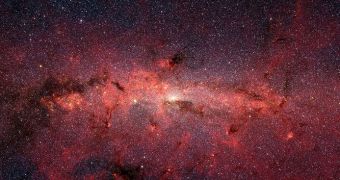Experts have finally been able to confirm the existence of cosmic particle accelerators in our galaxy, the Milky Way, after years of studies.
Astrophysicists have known for a long time that some galaxies have portions that are capable of acting like giant particle accelerators, forcing various particles to move at nearly the speed of light.
But the new research represents the first instance in which such structures were discovered inside the Milky Way. Details of the work appear in the August 20 issue of the top scientific journal Physical Review Letters.
The investigation was conducted by researchers in the United States, at the University of California in Los Angeles (UCLA), who collaborated closely with colleagues from the Kyoto University, in Japan.
The findings were made using the largest cosmic ray detector in the world, the Argentina-based Pierre Auger Observatory, which is capable of detecting accelerated protons with incredible accuracy.
But data collected by the telescope revealed a puzzling fact – most of the cosmic rays in the Milky Way are actually made up of nuclei, not protons.
This means that they were most likely produced here, and not in other galaxies, as current theories had them pegged. The finding confirms the existence of natural particle accelerators in our galaxy.
“This finding was totally unexpected because the nuclei, more fragile than protons, tend to disintegrate into protons on their long journey through space,” UCLA professor of physics and astronomy Alexander Kusenko says.
“Moreover, it is very unlikely that a cosmic accelerator of any kind would accelerate nuclei better than protons at these high energies,” adds Kusenko, who is also a coauthor of the journal entry.
The expert now believes that the strong galactic magnetic fields the Milky Way contains have been trapping these gamma ray nuclei for millions of years.
“When the data came out, they were so unexpected that many people started questioning the applicability of known laws of physics at high energy,” Kusenko says.
“The common lore has been that all ultra–high-energy cosmic rays must come from outside the galaxy. The lack of plausible sources and the arrival-direction anisotropy (the nuclei have different physical properties when measured in different directions) have been used as arguments in favor of extragalactic sources,” he adds.
“However, since the cosmic rays in question turned out to be nuclei, the galactic field can randomize their arrival directions, taking care of the anisotropy puzzle,” he concludes.

 14 DAY TRIAL //
14 DAY TRIAL //